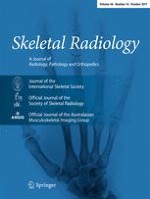Erschienen in:

01.08.2017 | Test Yourself: Answer
A teenager presenting with a forearm mass
verfasst von:
Rachel Kopkin, Carlos Gimenez, Ernest Rudman
Erschienen in:
Skeletal Radiology
|
Ausgabe 10/2017
Einloggen, um Zugang zu erhalten
Excerpt
The palmaris longus is a muscle of the upper extremity that exhibits a wide spectrum of anatomical variants, more so than other muscles of the upper extremity. In its most common form it is a small, fusiform muscle that functions as a vestigial flexor of the wrist and originates at the medial epicondyle as part of the common flexor tendon and inserts at the palmar aponeurosis volar to the flexor retinaculum [
1]. It receives its vascular supply from branches of the ulnar and brachial arteries and is innervated by the median nerve [
1]. …